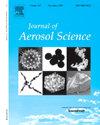Quantification of inhaled cigarette smoke movement and deposition in human nasal airways
IF 3.9
3区 环境科学与生态学
Q2 ENGINEERING, CHEMICAL
引用次数: 0
Abstract
Background
There are nearly one billion smokers worldwide, and cigarette smoke is not only a physical and chemical damage factor but also an allergen. Due to technical and ethical barriers, few studies have quantitatively measured the deposition of cigarette particles on the nasal mucous membranes of humans or animals.
Methods
CT data of nine healthy adults were recruited to construct nasal airway models and conduct numerical simulation using Computational Fluid Particle Dynamics (CFPD) approach. Deposition fractions in each nasal regions under different breathing conditions were analyzed, and the transport process of cigarette particles from the initial releasing locations at the nostrils to the final deposited sites were traced.
Results
1) For sub-micron particles like cigarette smoke, their deposition due to the nasal filtration function in nasal airways is very limited, about 3.45% of the particles are deposited in the nasal cavity under the rest inhalation condition, with the majority being inhaled into the downstream airways. 2) Increased particle collision and deposition were observed in the nasal airway under intense inhalation condition. 3) Cigarette particles deposited in the paranasal sinuses and the olfactory region were inhaled from the inner superior corner of the nostrils (covering 1/3 or even 1/2 of the nostril plane). In contrast, particles deposited in other nasal regions showed no clear release pattern, as the initial inhaled locations were more dispersed across the nostrils.
Conclusion
This study advances the current understanding of secondhand smoke exposure characteristics in human nasal passages. (1) The vast majority of cigarette smoke particles go straight into the downstream airways. (2) Smoke particles deposition pattern in the nasal airway was widespread and evenly distributed, and those deposited in the paranasal sinuses and the olfactory region were inhaled from the inner superior corner of the nostrils. (3) This study highlighted the damage caused by the secondhand smoke, emphasized the need for strengthened smoke management and education, and suggested the implement of proactive allergen protection measures under smoke exposure scenarios.
吸入香烟烟雾在人鼻气道中的运动和沉积的定量
全世界有近10亿吸烟者,香烟烟雾不仅是一种物理和化学伤害因素,也是一种过敏原。由于技术和伦理的障碍,很少有研究定量测量香烟颗粒在人类或动物鼻粘膜上的沉积。方法采用计算流体粒子动力学(CFPD)方法建立9例健康成人鼻气道模型,并进行数值模拟。结果:1)对于亚微米颗粒,如卷烟烟雾,由于鼻腔过滤作用,其在鼻道内的沉积非常有限,在休息吸入条件下,约有3.45%的颗粒沉积在鼻腔内;其中大部分被吸入下游气道。2)强吸入条件下,鼻气道内颗粒碰撞和沉积增加。3)香烟颗粒沉积在鼻窦和嗅觉区,从鼻孔内上角(覆盖鼻孔平面的1/3甚至1/2)吸入。相比之下,沉积在鼻腔其他区域的颗粒没有明显的释放模式,因为最初吸入的位置在鼻孔中更分散。结论本研究提高了目前对人鼻道二手烟暴露特征的认识。(1)绝大多数香烟烟雾颗粒直接进入下游气道。(2)烟雾颗粒在鼻道内的沉积规律广泛且分布均匀,沉积在鼻窦和嗅觉区的烟雾颗粒主要由鼻孔内上角吸入。(3)本研究强调了二手烟的危害,强调了加强烟雾管理和教育的必要性,并建议在烟雾暴露情景下实施主动的过敏原保护措施。
本文章由计算机程序翻译,如有差异,请以英文原文为准。
求助全文
约1分钟内获得全文
求助全文
来源期刊

Journal of Aerosol Science
环境科学-工程:化工
CiteScore
8.80
自引率
8.90%
发文量
127
审稿时长
35 days
期刊介绍:
Founded in 1970, the Journal of Aerosol Science considers itself the prime vehicle for the publication of original work as well as reviews related to fundamental and applied aerosol research, as well as aerosol instrumentation. Its content is directed at scientists working in engineering disciplines, as well as physics, chemistry, and environmental sciences.
The editors welcome submissions of papers describing recent experimental, numerical, and theoretical research related to the following topics:
1. Fundamental Aerosol Science.
2. Applied Aerosol Science.
3. Instrumentation & Measurement Methods.
 求助内容:
求助内容: 应助结果提醒方式:
应助结果提醒方式:


